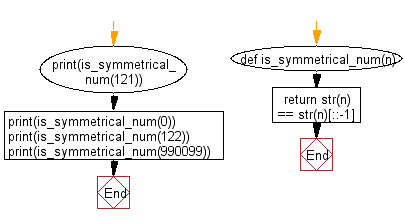Python: Test whether a given number is symmetrical or not
Symmetrical Number Checker
Write a Python program to test whether a given number is symmetrical or not. A number is symmetrical when it is equal to its reverse.
For example- 121 is the symmetric number.
Sample Solution:
Python Code:
# Define a function to check if a number is symmetrical
def is_symmetrical_num(n):
# Convert the number to a string and compare it with its reverse
return str(n) == str(n)[::-1]
# Test cases
print(is_symmetrical_num(121)) # True, as 121 is a symmetrical number
print(is_symmetrical_num(0)) # True, as single-digit numbers are symmetrical
print(is_symmetrical_num(122)) # False, as 122 is not a symmetrical number
print(is_symmetrical_num(990099)) # True, as 990099 is a symmetrical number
Sample Output:
True True False True
Explanation:
Here is a breakdown of the above Python code:
- The function "cal_median()" takes a list of numbers as input.
- The list is sorted in ascending order using the "sort()" method.
- The length of the list ('n') is calculated, and the middle index ('m') is determined.
- If the length is even, the average of the two middle numbers is returned; otherwise, the middle number is returned.
- Test cases are provided to demonstrate the function's functionality.
Visual Presentation:
Flowchart:

For more Practice: Solve these Related Problems:
- Write a Python program to check if a number is symmetrical by comparing it with its reverse.
- Write a Python program to determine if a given integer reads the same forwards and backwards without string conversion.
- Write a Python program to verify if a number is symmetrical using arithmetic operations to reverse its digits.
- Write a Python program to check for symmetry in a number by iteratively extracting and comparing its digits.
Go to:
Previous: Write a Python program to calculate the median from a list of numbers.
Next: Write a Python program that accepts a list of numbers. Count the negative numbers and compute the sum of the positive numbers of the said list. Return these values through a list.
Python Code Editor:
Have another way to solve this solution? Contribute your code (and comments) through Disqus.
What is the difficulty level of this exercise?
Test your Programming skills with w3resource's quiz.
